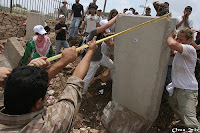
I think that we should be men first, and subjects afterward. ...Read Henry David Thoreau's "Civil Disobedience" online.
Unjust laws exist; shall we be content to obey them, or shall we endeavor to amend them, and obey them until we have succeeded, or shall we transgress them at once? Men generally, under such a government as this, think that they ought to wait until they have persuaded the majority to alter them. They think that, if they should resist, the remedy would be worse than the evil. But it is the fault of the government itself that the remedy is worse than the evil. It makes it worse. Why is it not more apt to anticipate and provide for reform?
- Thoreau, "Civil Disobedience"
A search on Flickr for "civil disobedience" surfaces some remarkable photos, including several depicting the above action in Izbet Tabib, where Israelis and Palestinians joined to remove part of the wall between the two states.





